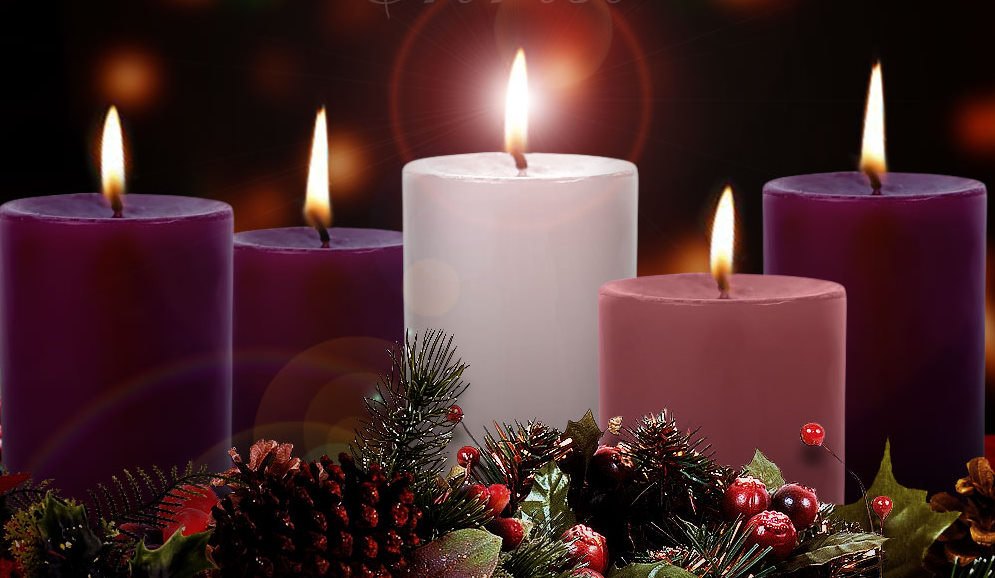What is Advent?

Advent candles with the white candle representing Christ Jesus like this are used in many churches around the world. File photo.

The season of Advent ends today for Christians around the world. What is Advent? The word comes from the Latin word adventus meaning “coming” or “visit.” Advent begins four Sundays before Christmas and ends on Christmas Eve. Advent is also the beginning of the liturgical year for Christians. But what does Advent mean? What does it represent?
During Advent, believers are remembering what it was like prior to the birth of Jesus. They prepare for, and anticipate, the coming of Christ. Christians remember the longing of Jews for a Messiah and for their own longing for, and need of, forgiveness, salvation and a new beginning. It is looking back to the manager while also looking forward in expectation of Christ coming again.
Each week a candle is lit marking the step closer to the celebration of the birth of Christ at Christmas. Different denominations focus on slightly different themes for each week, but they are similar. Each week believers are asked to contemplate, to examine themselves and grow in their faith. In an Advent observance, there are four candles. The candles may be arranged in a wreath, or in a line. Three are purple candles and one is pink. A separate candle, typically in the center is white representing Christ and his birth at Christmas. The Christ candle is lit on Christmas Eve, Christmas Day and/or the Sunday following Christmas. Blue is also used in some denominations instead of purple as a symbol for the Advent season and in use with the candles.
The order of the themes for each week in Advent may vary slightly between churches and denominations. Typically the themes are Hope, Peace, Joy, and Love.
The first Sunday in Advent is Hope. It is to remind believers of the need for hope, the coming of Christ. The people remember they need God to bring healing, comfort, redemption, and salvation. It embodies the voice of broken people crying out for savior, for healing, in a world filled with suffering, conflict and violence. Advent is a time of expectation and hope of the coming Messiah from the perspective of the Jews while also reflecting on the current state of the soul of the individual believer. Believers are asked to contemplate questions such as, “Where is my hope? Where am I with my relationship with Jesus?”
The second Sunday in Advent candle represents Peace. The second candle calls believers to remember where their true peace comes from. One of the titles of Christ is the Prince of Peace. It is through the Holy Spirit that believers find peace “which surpasses all understanding”. In a broken world, a world of turmoil and chaos, peace can be found for believers in Christ. It is this Peace which should enable believers to act upon their faith with courage. Believers are called to examine themselves asking, “Where does my peace come from? Do I have peace? Am I living a life that speaks of God’s peace at work in my heart? Am I living my faith with courage, grounded in that peace?”
The third Sunday in Advent candle is pink and represents Joy. This candle calls believers to remember the joy of salvation, of the promises of God. They remember that it is God that tear down walls of despair and sorrow. As the prophets found joy in the midst of hardships through God, so are the believers of today to remember where their true joy relies upon. Believers are called to remember their true source of joy and to contemplate, “Where is my joy? Am I living a life that speaks to God as the source of my joy?”
The fourth Sunday in Advent represents Love. The second candle calls believers to remember the faith and belief in the creation of the universe, that God through his love created all. They are asked to remember that love and the love of God for his people to provide a way for salvation. They are also called to remember that love and in turn show it in their actions, words and deeds with others. Christians are called to love as Christ loves them. Believers are asked to contemplate, “Do I love God? Have I accepted His love for me? Am I living a life that speaks of love? Am I showing love towards others, even those I find difficult to love?”
Finally, during a Christmas Eve service, Christmas Day service or even the following Sunday, the white candle representing Christ is lit.
While the colors or the specific representation of the candles such as hope, peace, joy and love may change, the asking of Christians to “prepare their hearts for the coming of Christ” is the same. Can they receive the Christ child into their hearts? What does the Nativity truly mean to them? It is also a way to focus on what Christmas means for Christians instead of gifts and holiday hustle and bustle. In the midst of holiday festivities, Advent calls the believer to set aside quiet moments of contemplation.
Many families have Advent wreaths at home and in addition to the readings and reflections during church services, lit their own candles and set aside time for reflection and observance daily with one another. It offers the opportunity to also tailor the reflection to the appropriate age level of children as well. It is a way of telling the Christmas story at home, sharing the faith and allowing for family time together as well.
Advent calls the faithful to contemplate the Christmas story tells of Mary, Joesph and the baby Jesus. Is there room for Christ in their hearts?









